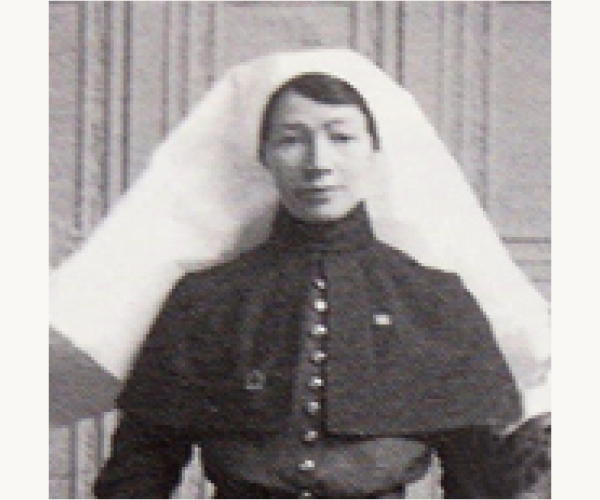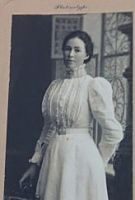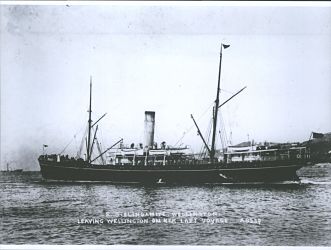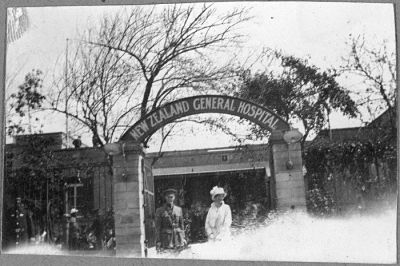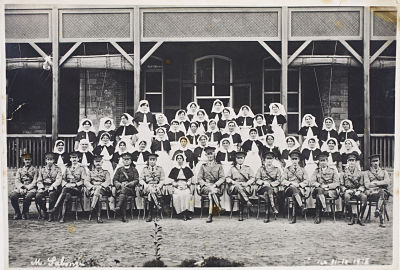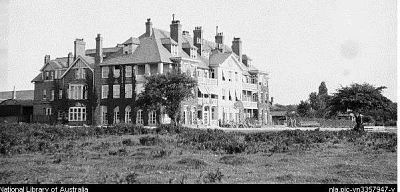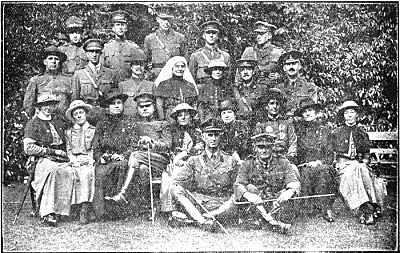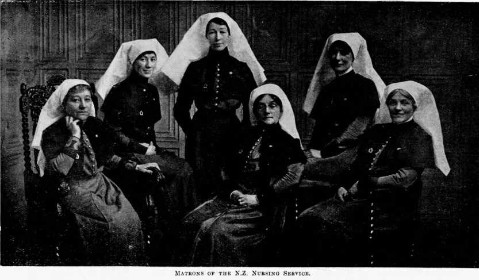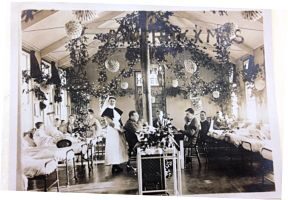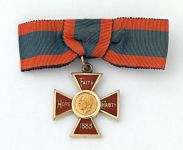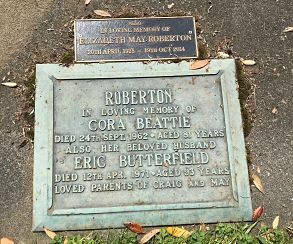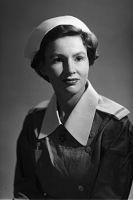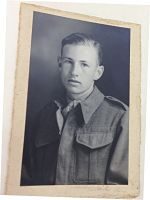WW1 Matron Cora Beattie Anderson
Cora Beattie Anderson of Remuera had a distinguished war record as a nurse during World War One after she had survived a major shipwreck.
Cora Beattie Anderson was born on the 4th March 1881, one of eight children of Annie and William Anderson, who under the new Auckland City Council of 1871 was appointed City Engineer. She attended Auckland Girls Grammar School from 1895 to 1898.(1) At the time of her attestation in April 1915 to join the New Zealand Army Nursing Service (NZANS), her address was given as 4 Roslyn Avenue (now Entrican Ave), Remuera.
Cora was a survivor of the dramatic wreck of the Elingamite which sank after striking one of the Three Kings Islands in 1902. The passenger steamer Elingamite had been returning from Sydney to Auckland when in dense fog 35 miles north of Cape Reinga it struck rocks. On board were 136 passengers and 58 crew, and a consignment of 52 boxes of coins for banks in New Zealand, including 6,000 gold half-sovereigns. 28 passengers and 17 of the crew died from drowning or exposure. Cora who was 21 years old was on the last lifeboat with her brother-in-law Dr Robert Beattie who was Medical Superintendent of the Auckland Lunatic Asylum (Carrington/Oakley Hospital).
Dr Beattie’s account of that day was published by the New Zealand Herald: (2)
“The Elingamite struck one of the Three Kings about half-past ten on Sunday morning during a dense fog. The captain was on the bridge, and a man on the lookout, but the breakers were not observed until the steamer was almost on the rocks. The engines were stopped rapidly, which caused me to look over the port side, when I. saw high, towering rocks towards which the steamer was slowly moving. She bumped softly at first, but soon the crash became appalling, and within, half an hour the deck was half wider water, “Several boats got away safely. Miss Anderson and myself, with several others, whose names I do not know, got into what we believed was the last boat that could be launched. We were then fairly waist high in water on the deck, and remained there only with difficulty. We were only a short time on the boat when she swamped and capsized.
By this time we had launched the last lifeboat, which could not be launched previously. All the ropes were already cut, and as the boat floated gently off five or six passengers who were on the upper deck, stepped into her and made for us. Miss Anderson was the first to be picked up, then myself, and then a few other passengers, and soon after the first and second mates, who at once assumed command. By this time all the other boats had disappeared, and we remained to pick up all the passengers seen floating on the wreckage. We numbered 45 in all, and one dead body, and we set sail to find the Cape Maria light. The night being misty we failed to find it, and waited anxiously for daylight, but the mist continued. About eight a.m. the mist cleared slightly for only a few minutes, and we were unable, to find land. “We then set out on our course again, and landed on a sandy beach at Cape Kowhai, about half-past twelve p.m. We were 25 hours in the open boat, much cramped, and extremely cold, and sailed probably considerably over 100 knots.
Late in the afternoon of Sunday we sighted a boat believed to be the captain’s, apparently making for Cape Maria, but soon lost sight of her again, and saw no other boats after starting out. Several passengers floated away on rafts, and five were left on the steamer. We passed four or five dead bodies before clearing the wreckage. The steamer was obviously a total wreck. “Practically all on board kept cool, and the officers and men were heroic. One seaman asked us not to take him on board until all the others had been picked up. “All the passengers landed are well, but somewhat exhausted. The Maoris and pakehas treated us splendidly.” (3)
It may have been this life-threatening experience that led Cora to become a nurse. She trained and graduated at Thames Hospital in 1909 and then completed midwifery training at St Helen’s Hospital in Auckland. In 1910 she was appointed matron of the Townley Maternity Home, Gisborne,(4) and in 1912 district nurse for Maori patients in the Rotorua district. Then it was reported “After two year’s work, Miss Cora Anderson is resigning the position of Native Health Nurse at Rotorua.(5) Her resignation is accepted with the greatest regret by the Health Department. Miss Anderson intends to live in Auckland with or near her mother.”(6)
After war broke out in August 1914, Cora was one of the first selected for the contingent of 50 nurses to be sent for service under the direction of the British War Office.(7) She joined the New Zealand Army Nursing Service (No. 22/12 on the list of 50) and was age 34 when she set sail on the steamer Rotorua on 8th April 1915 for London.
Cora reported from London on May 20th:(8) “We all arrived safely and well yesterday. Nurse Cormack had a sharp attack of sciatica, but is better now, and no one else had worse than sea-sickness or a cold. We all enjoyed the ports immensely, and our train ride from Plymouth up was lovely, hyacinths, primroses, etc., growing wild and everything looking green and lovely. We had a consort from Teneriffe, I believe, though we did not see it. We are all going to base hospital in Egypt and leave immediately. Are going up to the High Commissioner’s office now. There are twenty five of us here, and the rest are in smaller parties at other homes. We were met at Plymouth by Mr. Eley from the New Zealand Office and had a reserved carriage. Later we have been up to the office and are to go again this afternoon. We leave either in three days or ten by transport from London Docks. Mr. Mackenzie is taking us to afternoon tea to-morrow and to Buckingham Palace on Saturday. We have had no mail so far but hope there may be some to-day. I think there was a New Zealand mail on the Lusitania: and hope there was none for us. London is full of recruiting bands and enlistment advertisements and uniform”.
By the time the S. S.Rotorua reached Plymouth on 19 May 1915 the New Zealand nurses knew they were bound for Egypt. Nurses were badly needed in the British hospitals there to nurse the sick and wounded from Gallipoli. On 3 June the nurses sailed for Alexandria to be assigned to hospitals there and in Cairo.
Cora was promoted to Sister on 1st February 1916 and posted to the No. 1 New Zealand General Hospital, Cairo, where she wrote:(9) “Cairo just now is lovely, though the last two or three days have been very hot. The orange blossoms are out, and some large trees in our garden are all one mass of pretty pink blooms like tulips, which harmonise beautifully with the bouganvillia, which is climbing in some of the other trees. With the white tents erected m the garden, it makes a very pretty picture. “They had just been a trip to the Barage with some of the patients. The trips are arranged with gift money and the men enjoy it very much.” Image:Entrance to the New Zealand General Hospital, Pont de Koubbeh, Cairo, Egypt, during World War 1 National Library of N Z Reference Number: 1/2-147599-F
On August 13, 1915 Cora wrote to her brother “We are right in the thick of things, wounded and sick coming in faster than we can take them..
One hundred and fifty cases came in the day before yesterday, and 91 came in last night. Beds and mattresses are all round the corridors and verandahs. As every few patients go out a fresh batch is put in, and another surgical ward downstairs has had to be used for gastro-enteritis and dysentery cases. The men say it is just like Heaven to be here, and one feels that one cannot do enough for them. Some that we get are absolute wrecks, but a few days’ sleep and baths and feeding, books and papers and the chance of seeing some ordinary fellow mortals and a few women about soon set them right again, and they begin to look as if they had wakened out of a sleep. I go round and see that they are all shaved and tidy, etc., in the morning, and feel quite proud of my flock. When I went this morning I found men sleeping on mattresses on every available patch of the floor, 100 for whom we had no beds. I believe we are to make our accommodation up to 1,000 beds. We feel that we are doing what we came for, and are all putting every available ounce of ourselves into the work.”
We have 650 patients in the hospital, and are discharging them by fifties and hundreds to make room for new and worse cases. We have them in tents, verandahs and corridors, and the doctors are operating from 6 a.m. till the heat of the day gets too great, then in the afternoon and right on into the evening and night. There seems to be a very great many head and arm wounds among them. The men who left here just a week ago are coming back now, wounded. They went straight into action when they arrived. It is said that they have done wonderful things at the peninsula, however, and our men get the very greatest praise.”(10)
The nurses’ efforts and conditions in Egypt were later described in the official war record:
The nurses had many difficulties to contend with; their quarters were cramped and inconvenient; they were frequently very short staffed, as only a proportion of the nurses arriving subsequently from New Zealand could be sent here; the heat was very trying; and working in tents and pavilions pitched on the sand tested their endurance. The serious cases of dysentery and of enteric from Gallipoli necessitated nursing skill of the highest order, and brought forth all the loving kindness and patience that accompany the skill of a good nurse.(11)
Image:No. 1 N Z General Hospital Cairo: Cora Anderson 3rd row from front 8th from left AWMM 379134 Mackrell, Brent. Papers. Auckland War Memorial Museum Library. MS-2003-107
In June 1916 Cora was mentioned in despatches by Lieut. Gen Sir John Grenfell Maxwell who as General Officer Commanding British Troops in Egypt brought to notice of the Secretary of State for War her name in recognition of valuable services in administration in Egypt. Cora was also brought to the notice of the Secretary of State for War for valuable services rendered in connection with the war in March 1917.(12)
Cora sailed on the Hospital Ship Marama in June 1916 from Alexandria in Egypt to Southampton and then transferred to the No. 1 N Z General Hospital at Brockenhurst (left). There she was Matron, with Sister Elizabeth Dixon, of the Morant (Marrant) Convalescent Home, an auxiliary war hospital.
Cora served as matron of most of the major New Zealand hospitals in England. In December 1916, she was made Matron of the No. 3 New Zealand General Hospital No.3 at Codford on the Salisbury Plains, England and then in April 1917 Matron of the Hornchurch Convalescent Hospital, known as Grey Towers, in Essex, near London, which accommodated 2,500 patients with a well-equipped physiotherapy department for treating 400 patients daily. By the end of 1918 about 20,000 patients had been treated at Hornchurch.
In June 1917 a significant meeting took place – the five New Zealand matrons and medical officers entertained a visit at No. 2 N Z General Hospital at Walton on Thames from their new allies in the war – this included matrons, nurses and medical officers from Canada and the USA as well as Australia. The five New Zealand matrons present were, besides Miss Thurston Matron in Chief R.R.C., Miss Fanny Wilson A.R.R.C., Matron of Walton, Miss Vida MacLean A.R.R.C., Matron of Brockenhurst, Miss Cora Anderson, Matron of Hornchurch, Mrs. Plowman, A.R.R.C., (formerly Sister Elizabeth Nixon), Matron of Codford, and Miss Chalmers, Sister-in charge of Oatlands Park.(13)
From left to right:
Miss Thurston, Matron-in-Chief, NZ Expeditionary Force.
Miss Maclean, Matron-in-Chief No. 1 N Z General Hospital, Brockenhurst.
Miss Anderson, Matron N Z Convalescent Hospital, Hornchurch.
Miss Price, Matron, N Z Stationary Hospital, France.
Miss McNie, Matron, No. 3 N Z General Hospital, Codford.
Miss Wilson, Matron, No. 2 N Z General Hospital, Walton-on-Thames.
On 15 November 1917, Matron Cora Anderson was recommended by the Minister of Public Health to attend special training in the administration of anaesthetics, at a cost of £100, a responsibility normally given to a trained doctor. These awards, recognition and promotions recognise that Matron Cora Anderson was a very respected and capable nurse as well as nursing administrator. (14)
In February 1918 Mrs W. H. Parkes, wife of Lieut. Colonel William Henry Parkes, wrote a letter about Christmas at Hornchurch (15) –
It was bitterly cold, but a beautiful day and the writer says that many of the men came from Auckland, and knew her, although she did not know them. As it was Christmas Day, they went to the 9.30 service, where Padre Burton (Anglican) and Padre McDonald (Presbyterian) conducted the service together. They had a very excellent brass band, which played very well indeed. “As soon as this was over,” the writer proceeds, we had a sup of tea with the O.C., Col. Tewsley and Mrs. Tewsley in the matron’s room. Miss Cora Anderson (sister of Mrs. Beattie) is matron. Miss Thurston, the matron in chief, had come down previously.”
Cora received further decoration when she was made an Associate Royal Red Cross (2nd-Class) in October 1917 in recognition of her valuable service in connection with the War while Matron of Hornchurch (16). In July 1919 Cora was awarded the Royal Red Cross, 1st Class, again for her valuable service in connection with the war.(17) The arms of the Royal Red Cross First Class bear the words Faith, Hope, Charity, 1883. Cora’s medals and badges are held at the Auckland War Memorial Museum.(18)
In February 1919 Cora was diagnosed as suffering from stress and strain with low blood pressure due to active service. The medical board recommended six weeks leave on full pay.(19) She boarded the S S Rimutaka on 28 May 1919 to return home to New Zealand but was in charge of all the nursing staff on board. Again in July on board she was assessed as suffering from debility and put on extra leave for 6 weeks, with a recommendation of demobilisation. Cora arrived in New Zealand on 26 August 1919 and was discharged from service but remained on the Service and Temporary Reserve of the NZANS until official retirement in July 1921. Cora served overseas for 4 years and 50 days. After the war, Cora was President of the Auckland Branch of the Returned Army Nursing Sisters Association for several terms.
On the 1st of October 1919 Cora married Eric Roberton. Eric Butterfield Roberton was a farmer at Tahora in Taranaki when WW1 broke out in 1914 – he was 39 (born 1877) when he enlisted in 1915. Sergeant Eric Roberton was reported as receiving a serious thigh wound and was removed to N Z General Hospital at Brockenhurst in England in October 1917 (20) – it was probably while recovering at Hornchurch that he met Cora. The Auckland Star reported – (21)
A quiet and pretty wedding took place on Wednesday last at the residence of the bride’s mother “Rahane.” Roslyn Avenue, Remuera when Miss Cora Anderson. R.R.C, third daughter of Mrs. and the late Mr. Wm. Anderson, C.E., and Mr. Eric E. Roberton (Stratford), youngest son of Mrs. and the late Mr. John Roberton of “Royston” Remuera, were married. The Rev. Pattison performed the ceremony. The bride, who was given away by her brother, Mr. W. B Anderson, wore her travelling dress of fawn tweed, with fawn crepe de chine hat with touches of pink, mauve, and blue, and carried a big posy of primroses. She was attended by her sister Miss Nan Anderson, who wore pale pink voile, and carried a loose bunch of pink and mauve sweet peas. The bridegroom was supported by his nephew, Mr. George Chamberlin. The rooms were beautifully decorated with flowers and the wedding took place in the drawing room, under a lovely wedding bell, the breakfast table being decorated in pink roses and white execorda. The wedding party consisted of the relatives of the bride and bridegroom.”
On April 20th 1925 Cora and Eric had a daughter Elizabeth May (22), followed by a son Craig. They farmed in the Taranaki until 1948, and then moved to Auckland to Bucklands Beach and Remuera.(23) On Cora’s death on 24 September 1962 aged 81, their address was 53 Upland Rd, Remuera. Eric died aged 93 on 12 April 1971. Cora and Eric are buried in Purewa Cemetery in Meadowbank, Auckland – Block M, Row 18, Plot 66. Their daughter Elizabeth who also became a nurse died aged 89 on 19 Oct 2014 and is buried with her parents at Purewa. The Meadowbank Retirement Village has named its pavilion The Cora Anderson Pavilion in honour of Cora’s achievements. (24)
Cora Beattie Anderson was awarded the following Decorations and Medals for her WWI service:
- Royal Red Cross (1st Class) (RRC)
- Associated Royal Red Cross (2nd Class) (ARRC)
- 1914-15 Star Medal
- British War Medal 1914-19
- Victory Medal, with oakleaf (for her Mentioned in Despatches (25)
